Stano Filko: A Retrospective18.3.–5.6.2022
Exhibition
With support of the Slovak National Gallery and the Linea Collection, Bratislava
With this retrospective of the work of Slovak artist Stano Filko, which has long been in preparation, the HALLE FÜR KUNST Steiermark takes a fresh look at a sustainably influential and utopian body of work. With generous loans from the Slovak National Gallery and the Linea Collection, Bratislava, this exhibition highlights the significance of this outstanding artistic position and its progressive design for society for today’s less visionary times.
Views
Stano Filko: A Retrospective, 2022
Exhibition Tour (English)
Camera & Sound: kunst-dokumentation.com

Stano Filko, A Retrospective, 2022
Exhibition view
Photo: kunst-dokumentation.com

Stano Filko, A Retrospective, 2022
Breathing: The Celebration of Air / Dýchanie: oslava vzduchu, 1970
Tarpaulin, electric motor, fan
Ø 550cm
Courtesy The Slovak National Gallery
Photo: kunst-dokumentation.com

Stano Filko, A Retrospective, 2022
The Monument – Czechoslovak Flag / Pomník – zástava Československa, 1968/1993
Metal, paint
220 x 80 x 50 cm
Courtesy Linea Collection, Bratislava; Layr, Vienna
Photo: kunst-dokumentation.com

Stano Filko, A Retrospective, 2022
Wind / Vietor, 1967/ca. 1995
Metal, synthetic paint, electric cable
3 objects, each 120 x 135 x 135 cm
Courtesy Linea Collection, Bratislava; Layr, Vienna
Photo: kunst-dokumentation.com

Stano Filko, A Retrospective, 2022
7 Chakra Colors Bench / Lavička vo farbách 7 čakier, ca. 2000
Found object, wood, acrylic
107 × 30 × 80 cm
Courtesy Linea Collection, Bratislava; Layr, Vienna
Photo: kunst-dokumentation.com

Stano Filko, A Retrospective, 2022
Self Portrait / Autoportrét, 1982
Collage, paint, cardboard
100 x 70 cm
Courtesy Linea Collection, Bratislava; Layr, Vienna
Photo: kunst-dokumentation.com

Stano Filko, A Retrospective, 2022
Exhibition view
Photo: kunst-dokumentation.com
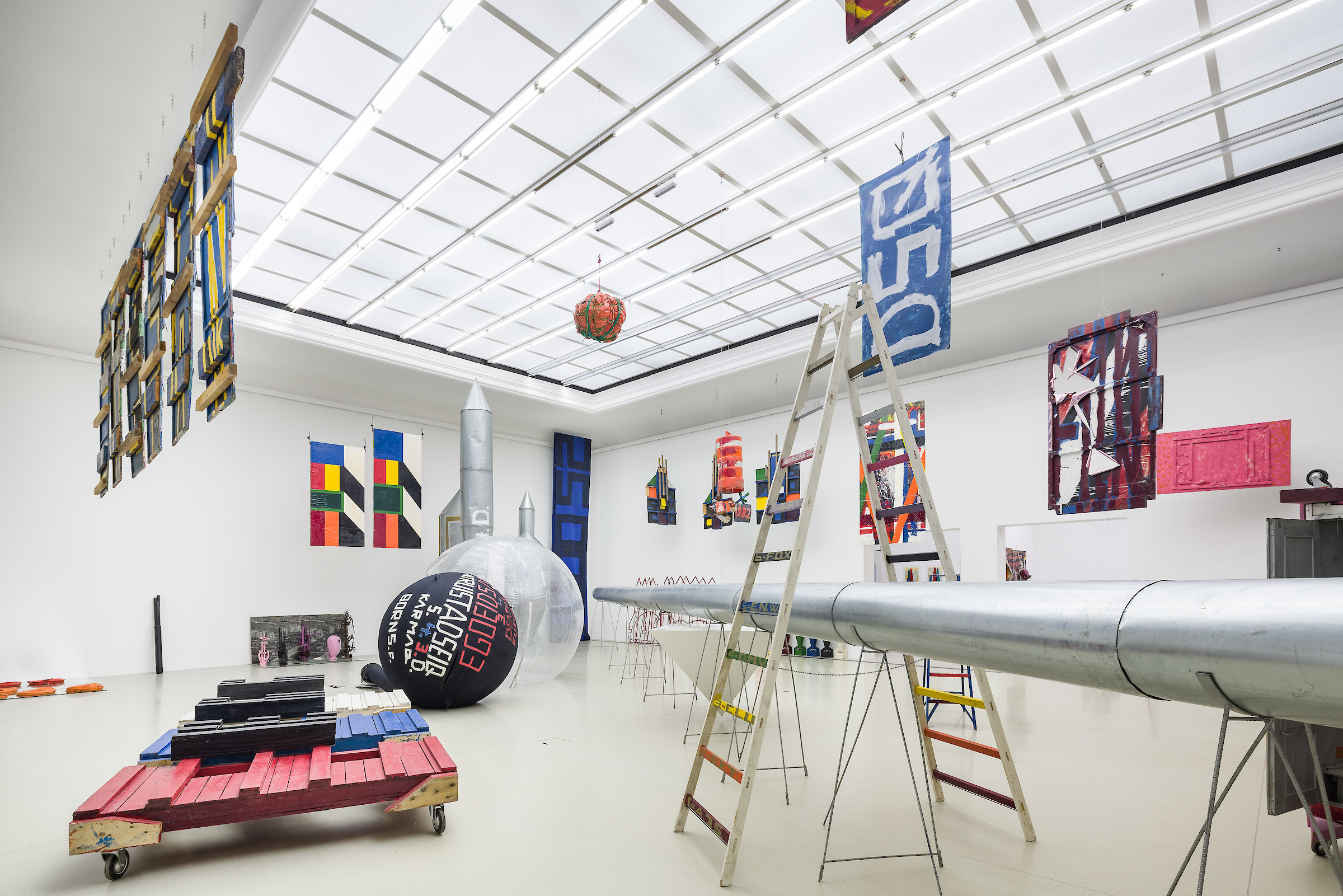
Stano Filko, A Retrospective, 2022
Exhibition view
Photo: kunst-dokumentation.com

Stano Filko, A Retrospective, 2022
Exhibition view
Photo: kunst-dokumentation.com

Stano Filko, A Retrospective, 2022
Exhibition view
Photo: kunst-dokumentation.com

Stano Filko, A Retrospective, 2022
TIMESPACE‑4.3.D. (Rockets) / TIMESPACE‑4.3.D. (Rakety), 1968/1993
Wood, acrylic and other materials
3 Objecte, je 180 x 108 x 12 cm, 208 x 108 x 11 cm, 197 x 104 x 8 cm
Courtesy Linea Collection, Bratislava; Layr, Vienna
Photo: kunst-dokumentation.com

Stano Filko, A Retrospective, 2022
Old and New Testament / Starýa Nový zákon, ca. 1995
Acrylic, oil, putty, hardboard
243 x 122 cm
Courtesy Linea Collection, Bratislava; Layr, Vienna
Photo: kunst-dokumentation.com

Stano Filko, A Retrospective, 2022
Woman – Venus – Scheherezade – Abstract / Žena – Venuša– Šeherezáda – Abstrakt, 1985
Mixed media
210 × 120 cm
Courtesy Linea Collection, Bratislava; Layr, Vienna
Photo: kunst-dokumentation.com

Stano Filko, A Retrospective, 2022
SPIRIT BABY, 1985
Mixed media
160 × 70 cm
Courtesy Linea Collection, Bratislava; Layr, Vienna
Photo: kunst-dokumentation.com

Stano Filko, A Retrospective, 2022
Shooting Range – Target Universe / Strelnica-terč: vesmír, 1966 – 67 / 2005
Object, collage, acrylic, wood, two rifles
350 x 180 cm
Courtesy Linea Collection, Bratislava; Layr, Vienna
Photo: kunst-dokumentation.com
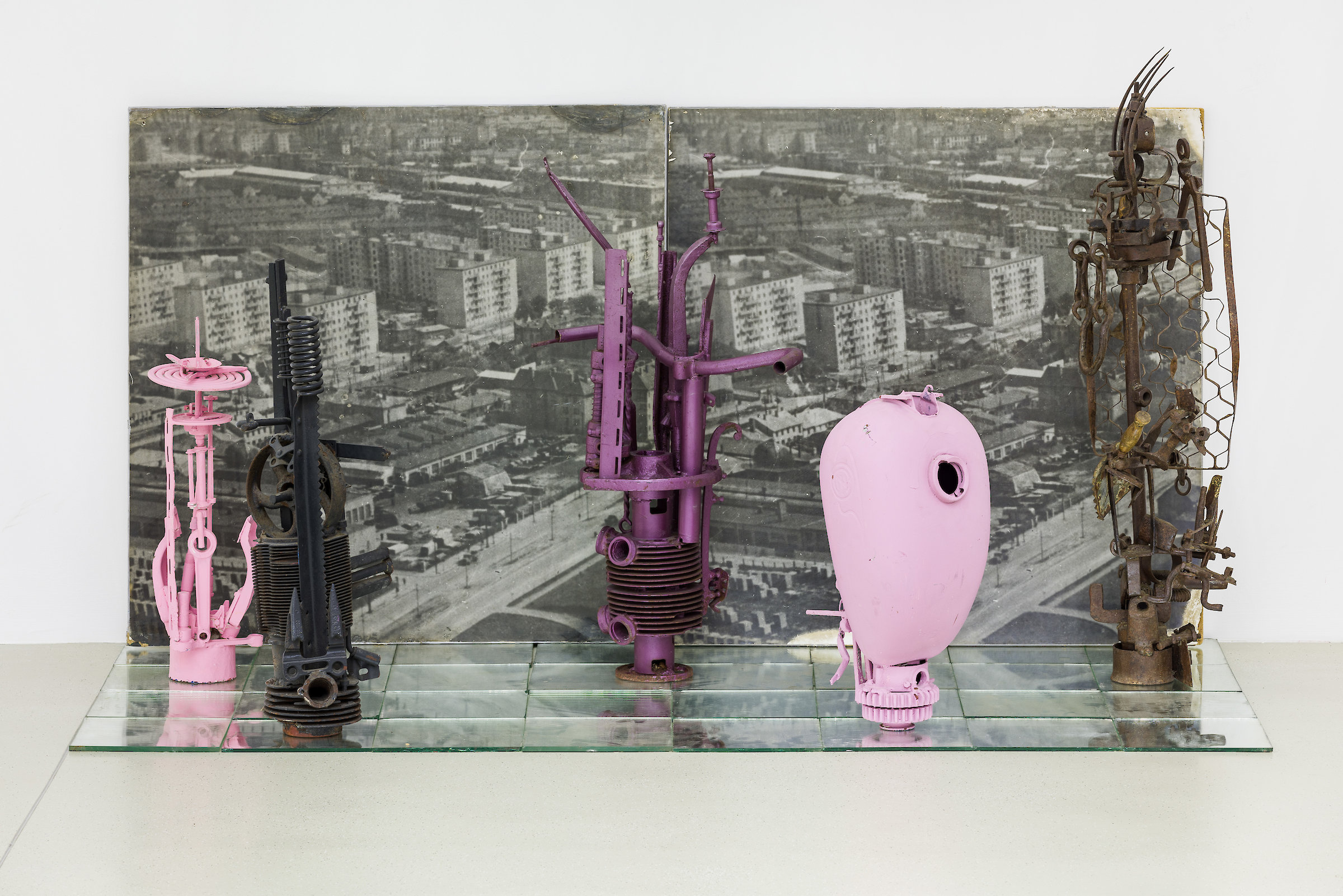
Stano Filko, A Retrospective, 2022
Model of Observation Tower / Model pozorovacej veže, 1967
Found object, metal, paint
60 x 29 x 21 cm
Model of Observation Tower / Model pozorovacej veže, 1966
Found objects, metal
82 cm x 19 x 23 cm
Model of Observation Tower / Model pozorovacej veže, 1967
metal, industrial paint
93 x 55 cm x 28 cm
Model of Observation Tower / Model pozorovacej veže, 1967
metal, paint
66 x 19 x 23 cm
Models of Observation Towers / Model pozorovacej veži, 1966 – 67
Print, cardboard, mirrors
3 pieces, each 100 × 100 cm
35 mirrors, each
25 x 26 x 0,6 cm
Courtesy Linea Collection, Bratislava; Layr, Vienna; The Slovak National Gallery, Bratislava
Photo: kunst-dokumentation.com

Stano Filko, A Retrospective, 2022
Exhibition view
Photo: kunst-dokumentation.com

Stano Filko, A Retrospective, 2022
From the series EGO – ON – IN – RED / Zo série EGO – ON – IN – RED, ca. 1990
Mixed media, paper
70 × 50 cm
Courtesy Linea Collection, Bratislava; Layr, Vienna
Photo: kunst-dokumentation.com
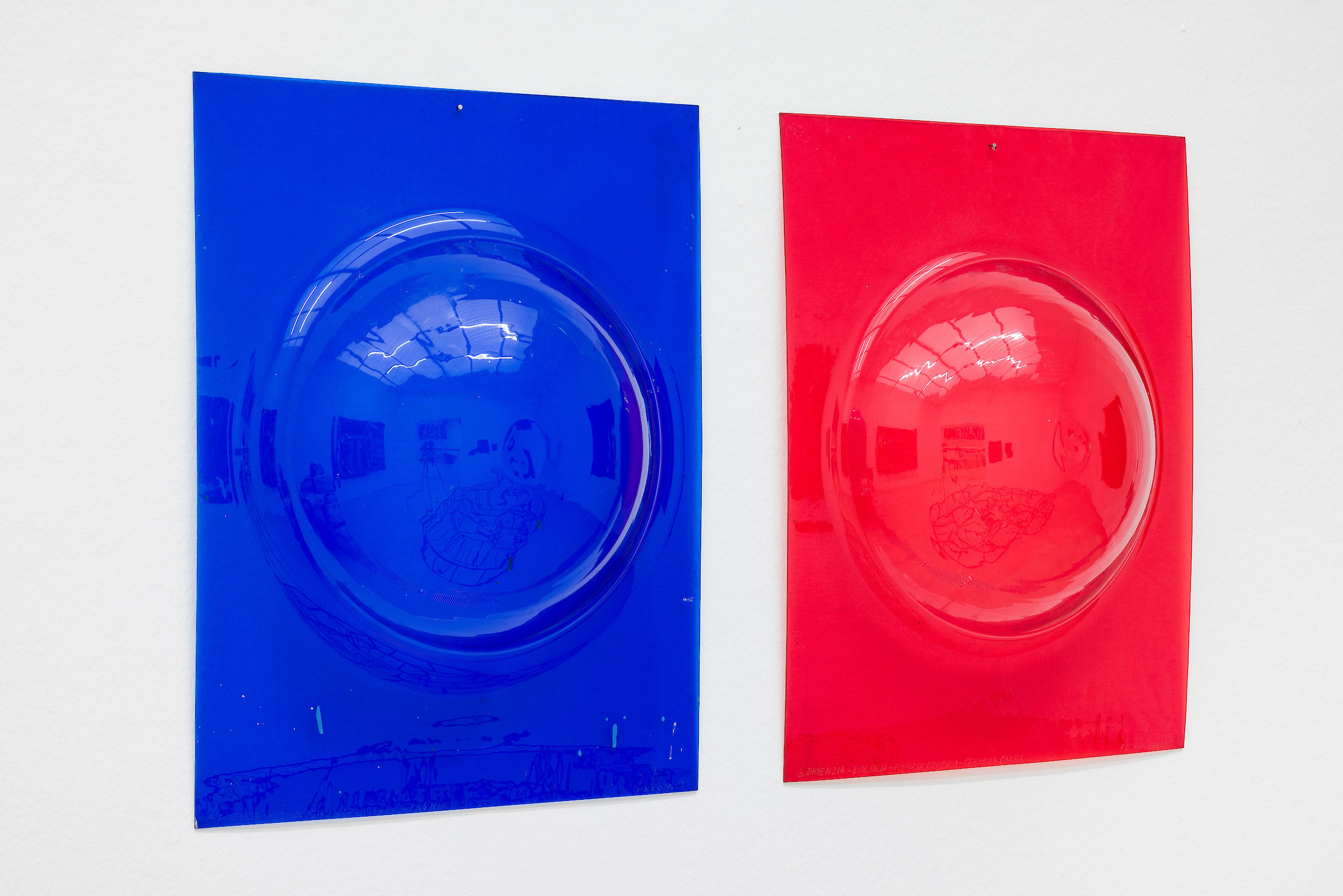
Stano Filko, A Retrospective, 2022
From the series Female Breast I – X (Red) / Zo série Ženský prsník I – X (Červený), 1966
Object, multiple, red Plexiglas, cord
74,5 × 56,5 × 17 cm
Courtesy Linea Collection, Bratislava; Layr, Vienna
Photo: kunst-dokumentation.com

Stano Filko, A Retrospective, 2022
SPIRIT – Shadow Super Head Baby, ca. 1985
Assemblage, found objects, painting
140 × 78 × 50 cm
Courtesy Linea Collection, Bratislava; Layr, Vienna
Photo: kunst-dokumentation.com

Stano Filko, A Retrospective, 2022
Exhibition view
Photo: kunst-dokumentation.com

Stano Filko, A Retrospective, 2022
From the series Map of the World (Rockets) / Zo série Mapa sveta (Rakety), 1967
Print from a lino stamper, pen, found cartographic print, paper
95 x 39,5 cm
From the series Map of the World (Rockets) / Zo série Mapa sveta (Rakety), 1967
Print from a lino stamper, pen, found cartographic print, paper
95 x 39,2 cm
From the series Map of the World (Woman) / Zo série Mapa sveta (Ženy), 1967
Print from a lino stamper, pen, found cartographic print, paper
95 x 42 cm
From the series Map of the World (Woman) / Zo série Mapa sveta (Ženy), 1967
Print from a lino stamper, pen, found cartographic print, paper
95 x 39,3 cm
Wooden Poles in Chakra Colors / Drevené tyče vo farbách čakier, ca. 2005
Paint, wood
9 pieces, each 400 cm long
Courtesy Linea Collection, Bartislava; Layr, Vienna
From the seriesHemispheres of Earth / Zo série Zenské pologule, 1967
Monotype
87 x 56 cm
From the series Map of the World (Rockets) / Zo série Mapa Sveta (Rakety), 1967
Monotype
121,4 x 39,1 cm
Courtesy The Slovak National Gallery, Bratislava
Photo: kunst-dokumentation.com

Stano Filko, A Retrospective, 2022
The Universal Environment / Univerzálne prostredie, 1966 – 67
Environment, plastic structure, plastic mesh screens with airbrush stencils, acetone paints, terrestrial and celestial globes, mirrors, projector, projection of slides on a screen, chess table, board and pawns
300 x 400 x 400 cm
Courtesy The Slovak National Gallery, Bratislava
Photo: kunst-dokumentation.com

Stano Filko, A Retrospective, 2022
The Universal Environment / Univerzálne prostredie (Detail), 1966 – 67
Environment, plastic structure, plastic mesh screens with airbrush stencils, acetone paints, terrestrial and celestial globes, mirrors, projector, projection of slides on a screen, chess table, board and pawns
300 x 400 x 400 cm
Courtesy The Slovak National Gallery, Bratislava
Photo: kunst-dokumentation.com

Stano Filko, A Retrospective, 2022
Exhibition view
Photo: kunst-dokumentation.com

Stano Filko, A Retrospective, 2022
From the series The Altar of Contemporaneity / Zo série Oltáre súčasnosti, 1965
Assemblage, collage, paint, mirror, metal, wood
143 × 127 × 31,5 cm
Courtesy Linea Collection, Bratislava; Layr, Vienna
Photo: kunst-dokumentation.com

Stano Filko, A Retrospective, 2022
Dresses from the exhibition Dwelling 66 of Reality Contemporaneity, 1967
Found objects, paint, textile
4 pieces, variable dimensions
Courtesy Linea Collection, Bratislava; Layr, Vienna
Photo: kunst-dokumentation.com

Stano Filko, A Retrospective, 2022
Grandpa – Grandma are Listening to the Radio / Dedko – babka počúvajú rádio, 1965
Assemblage, ready-made, found objects
Variable dimensions
Courtesy The Slovak National Gallery, Bratislava
Photo: kunst-dokumentation.com

Stano Filko, A Retrospective, 2022
Object (Reliquary), 1964
Found objects, glass, wire, acrylic, metal, wood
54 × 40 × 30 cm
Courtesy Linea Collection, Bratislava; Layr, Vienna
Photo: kunst-dokumentation.com
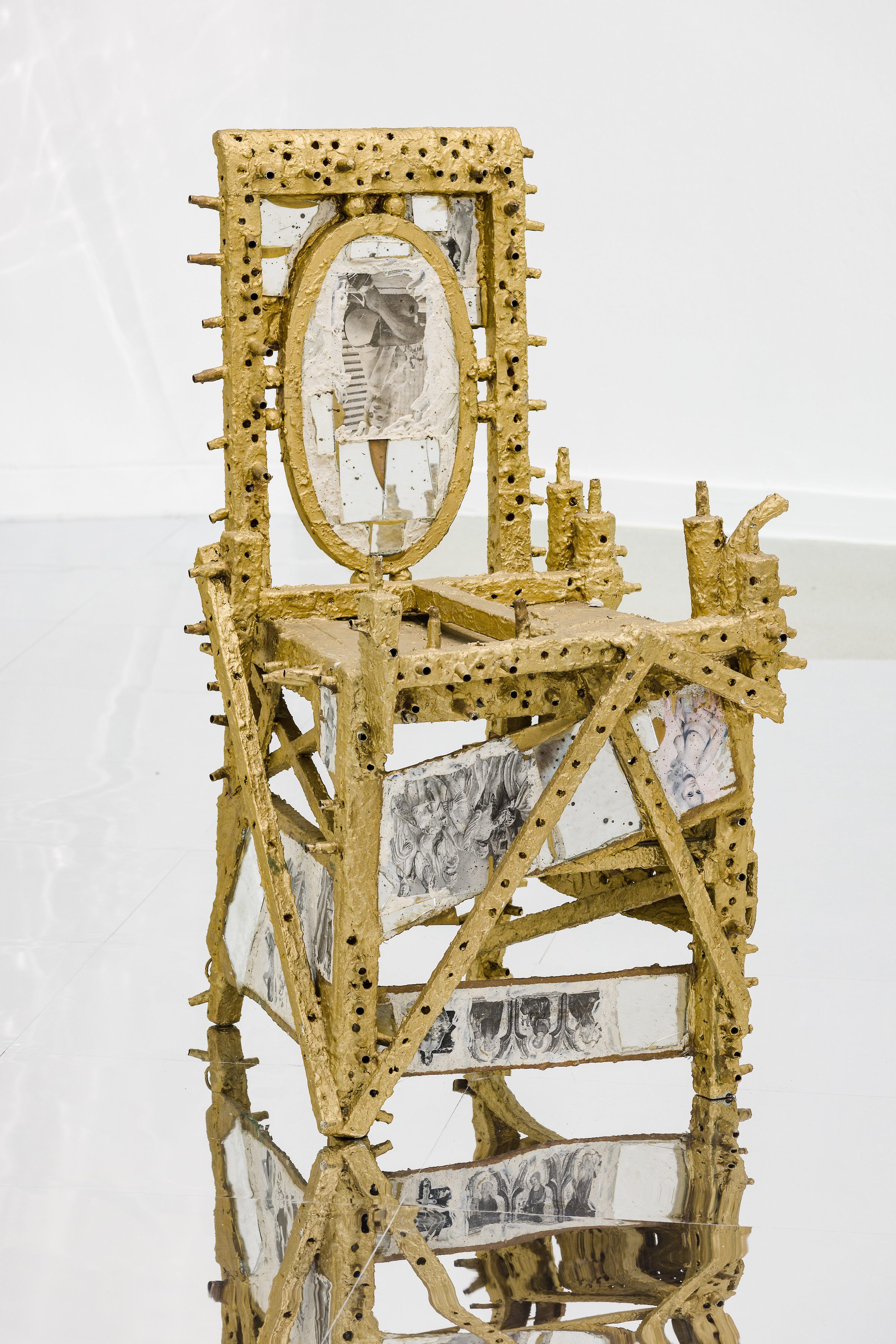
Stano Filko, A Retrospective, 2022
Chair II. / Stolička II. (From the series The Altar of Contemporaneity / Zo série Oltáre súčasnosti), 1965
Assemblage, collage, metal, golden pigment, mirror, metal, wood
90 x 60 x 55 cm
Courtesy Linea Collection, Bratislava; Layr, Vienna
Photo: kunst-dokumentation.com

Stano Filko, A Retrospective, 2022
Door (UISFO EGOQ) / Dvere (UISFO EGOQ), ca. 2000
Found object, mixed media, acrylic, glas, wood
190,5 x 120 x 10 cm
Courtesy Linea Collection, Bratislava; Layr, Vienna
Photo: kunst-dokumentation.com

Stano Filko, A Retrospective, 2022
Exhibition view
Photo: kunst-dokumentation.com

Stano Filko, A Retrospective, 2022
FILKO, ca. 1995
Found object, paint, wood
198 x 85 cm
Courtesy Peter Petrička, Bratislava
Photo: kunst-dokumentation.com

Stano Filko, A Retrospective, 2022
Monument to Traffic Signs. External Environment – Communication / Pomník značkám. Externé prostredie – komunikácia, 1967/ca. 1990
Installation, paint, wood, metal
Variable dimensions
Courtesy Linea Collection, Bratislava; Layr, Vienna
Photo: kunst-dokumentation.com

Stano Filko, A Retrospective, 2022
7 Chakra Colors (Wooden Formwork) / 7 farieb čakier (Drevené debnenie), ca. 1995
Installation, found wooden objects, acrylic, wire
Variable dimensions
Courtesy Linea Collection, Bratislava; Layr, Vienna
Photo: kunst-dokumentation.com

Stano Filko, A Retrospective, 2022
Exhibition view
Photo: kunst-dokumentation.com

Stano Filko, A Retrospective, 2022
Associations XXXX. (COS-MOS), Asociácie XXXX. (COS-MOS), 1969 – 70
Aluminum, perforations, polish
59,5 x 42,4 cm
Courtesy Linea Collection, Bratislava; Layr, Vienna
Associations XXXX. / Asociácie XXXX., 1969 – 70
Aluminum, perforations, polish
59,5 x 42,4 cm
Courtesy The Slovak National Gallery, Bratislava
Associations XXXX. / Asociácie XXXX., 1969 – 70
Aluminum, perforations, polish
59,5 x 42,4 cm
Courtesy The Slovak National Gallery, Bratislava
Associations XXXX. / Asociácie XXXX., 1969 – 70
Aluminum, perforations, polish
59,5 x 42,4 cm
Courtesy The Slovak National Gallery, Bratislava; Linea Collection, Bratislava; Layr, Vienna
Photo: kunst-dokumentation.com
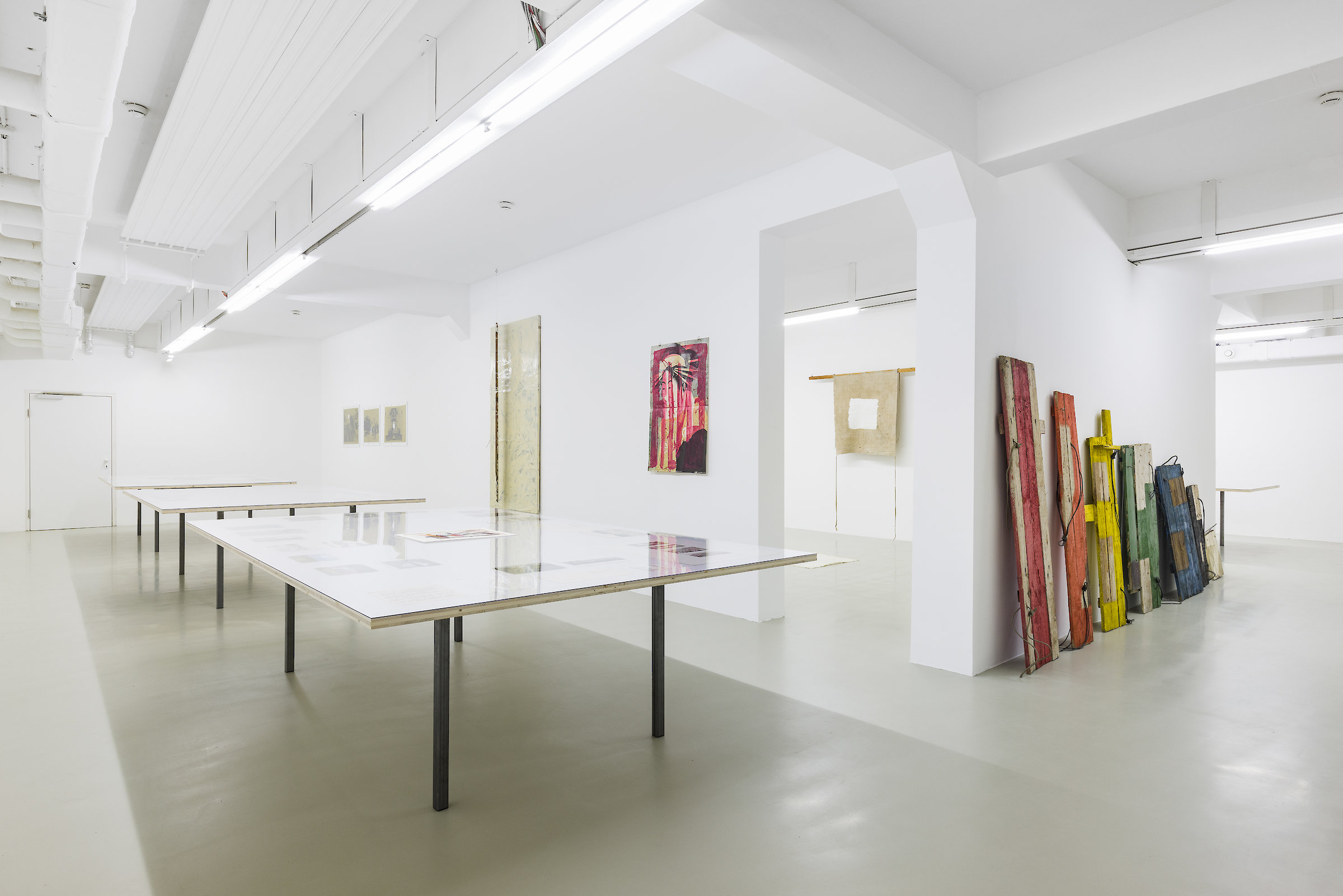
Stano Filko, A Retrospective, 2022
Exhibition view
Photo: kunst-dokumentation.com

Stano Filko, A Retrospective, 2022
Exhibition view
Photo: kunst-dokumentation.com

Stano Filko, A Retrospective, 2022
Exhibition view
Photo: kunst-dokumentation.com

Stano Filko, A Retrospective, 2022
Stano Filko, Miloš Laky, Ján Zavarský, White Space in White Space / Biely priestor v bielom priestore, 1973
White paint, felt
300 × 140 cm
Courtesy Linea Collection, Bratislava; Layr, Vienna
Photo: kunst-dokumentation.com

Stano Filko, A Retrospective, 2022
Stano Filko, Miloš Laky, Ján Zavarský, White Space in White Space / Biely priestor v bielom priestore, 1974
Paint, canvas, cardboard
20 tubes, each 135 cm, Ø 3,5 cm
Courtesy Linea Collection, Bratislava; Layr, Vienna
Photo: kunst-dokumentation.com

Stano Filko, A Retrospective, 2022
White Square / Biely štvorec, 1995
Wood, white paint, canvas
117 × 200 × 102 cm
Courtesy Linea Collection, Bratislava; Layr, Vienna
Photo: kunst-dokumentation.com
Text
With this retrospective of the work of Slovak artist Stano Filko, which has long been in preparation, the HALLE FÜR KUNST Steiermark takes a fresh look at a sustainably influential and utopian body of work. With generous loans from the Slovak National Gallery and the Linea Collection, Bratislava, this exhibition highlights the significance of this outstanding artistic position and its progressive design for society for today’s less visionary times.
Filko was an important representative of the central European neo-avant-gardes, with an oeuvre that developed over many decades and remains remarkably contemporary. He had great success in the 1960s but then became a persona non grata after the Prague Spring was defeated, and after several years he fled the country in daredevil manner in a Škoda 120L, which he then painted white and presented at the center of his participation in Documenta 7. Thereafter Filko emigrated to New York. Following the fall of the Iron Curtain he returned to Bratislava and established the studio building Snežienková in the style of a “total work of art” whose rooms and artworks all adhered in color and size to a prearranged structure called System SF.
This concept was on the one hand stringent and yet still flexible, enabling Filko not only to give structure to and question his expansive and originally conceptual work, but also to rethink ideas such as the transcendental in the sense of an overarching impulse, beyond any essentialist readings, which was evident in the media diversity and openness of this concept of art.
Filko’s complex oeuvre refers to the Fluxus, Nouveau Realisme, Dada, and Pop Art movements, while its independent multiperspectival development remains relevant today. In the early 1960s, Filko began to design installations, pneumatic sculptures, and utopian architectures that reflected his growing interest in cosmology and metaphysics. This was also seen in his happenings and actions. Always fascinated by anti-art, nihilism, and iconoclasm, Filko created several interactive environments based on his ideas of an open concept of media and interdisciplinarity.
To the last, Filko accompanied his artworks with texts, which he was always testing and rewriting. Notwithstanding all the creativity, this was a structured approach that made it possible for the artist to develop his projects simultaneously as production and reflection, as well as facilitating a better understanding of his originally conceptual approach. Thus Filko pursued a holistic way of working that places art and life together as one so as to work toward an alternative view of reality by means of the unbounded work of art.
This exhibition includes selected works from all the artist’s creative periods in order to draw attention from the systematic overview to individual works and their points of reference to each other. Alongside rooms focusing on specific themes or periods, the large exhibition hall in particular serves the purpose of presenting works from different phases together in loose and yet intensive arrangements, so as to see the autonomy and dynamics of each single work within a process of free association with the others. The distinctions between variously evaluated and studied different periods (the early phase that was recognized within a history of art, the neo-expressive “American” phase, and the self-reflective late phase) is here replaced by an overview and recognition of one entire artistic position.
Installations that show the artist’s enthusiasm for space travel and the exploration of outer space are planned for the exterior areas around the museum. The large-scale sculptures The Pyramid (1995) and DSUQ 4.D. Rocket (2000) will be displayed on the museum’s flat roof, each of them key artistic statements that combine the cosmos and the world. For the exhibition opening and finissage large balloon works (Breathing – The Celebration of Air, 1970; 12 Colors of Reality (Balloons), 1978 – 2011) will be presented in the surrounding Graz City Park.
Given the significance of Stano Filko’s large oeuvre established over several decades, and his charismatic personality, comparisons with meta-artists such as Joseph Beuys, Dieter Roth, and Paul McCarthy seem evident, and yet these would take us in the wrong direction, as it is important to avoid any stylization of Filko as a mythical artist figure whose excessive production and own theoretical frameworks might seem to lead to a hermetic interplay between the total work of art and a defined system. Rather Filko was concerned to overcome barriers and enter into dialogue. His works are characterized by a highly developed dialogic element and are often intended as offers for involving viewers. Not least thanks to his curiosity, liking of experimentation, and self-criticism Filko succeeded in keeping his works present, which is also due to his future-looking themes focusing on the cosmos and the body and spirit in reaction to – experienced and projected – realities.
Filko’s oeuvre is telling in particular because individual works often refute any kind of system. Unlike a classical retrospective, this exhibition tries not to present an oeuvre in a traditional manner, but to show it in the form of a first attempt at an overview that also activates single works, so as to emphasize the topicality and visionary in Filko today.
This project is accompanied by a program of events and education and a publication, with the participation of Lucia Gregorová Stach, Patricia Grzonka, Christian Höller, Mira Keratová, Hans Ulrich Obrist, Boris Ondreička, Jan Verwoert/Søren Grammel, and others.
Curated by Sandro Droschl
Artists
Participating artists
Stano Filko
The artworks of Stano Filko (*1937 Velka Hradna, †2015 in Bratislava) have been on show in renowned institutions such as the Slovak National Gallery, Bratislava; the Kunstmuseum Basel; Lentos Kunstmuseum, Linz; Kunsthalle Bratislava; Zacheta – National Gallery of Art, Warsaw; National Museum, Krakow; Fondazione Morra Greco, Naples; ZKM Zentrum für Kunst und Medien, Karlsruhe; Ludwig Múzeum, Budapest; Garage Project Space, Moscow; The New Museum of Contemporary Art, New York; P.S.1, New York; MACBA, Barcelona; Centre Pompidou, Paris; mumok, Wien; Kröller-Müller Museum, Otterlo; státna galléria (State Gallery), Banská Bystrica; Musée d‘Art Moderne, Paris; and Moravská galerie, Brno. His work attracted international attention amongst others at the 11. Biennale de Lyon, the Prague Biennale 3, the 51. Biennale di Venezia, the Documenta 7 in Kassel and the EXPO in Osaka. Gallery Emanuel Layr presented the artist at Frieze Art Fair London and at Art Basel.
Reviews
- der Standard, "Farben der Chakren und des Kosmos", Helmut Ploebst Print, 18.3.2022, PNG (4 MB)
- VIJENAC, "Umjetnici su bića treće, četvrte i pete dimenzije", Željko Kipke Print, 7.4.2022, PDF (5 MB)
- artmagazine, "Stano Filko - A Retrospective: Transzendenz der Farben", Walter Seidl Online, 20.4.2022
- ArtReview, "Stano Filko: A Retrospective", Christian Egger Print, 4.5.2022, PDF (301 KB)
- Kleine Zeitung, "Ein Hoch auf eine Welt der Utopien, Wenzel Mracek Online, 27.3.2022
- EIKON, "STANO FILKO A Retrospective", #118, 2022 Print, PDF (2 MB)
- Contemporary Art Library, Los Angeles Online
Press
Downloads & Dates
- Invitation card Stano Filko PDF (3 MB)
- Pressetext Stano Filko PDF (3 MB)
- Press text Stano Filko PDF (3 MB)